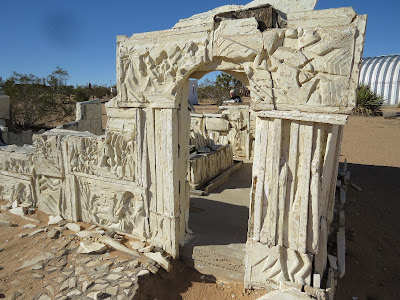 |
| Joshua trees and time-worn rocks along the Barker Dam trail at Joshua Tree National Park. |
Winter 2024 seemed like a good time to try to see two of California's desert parks, Joshua Tree and Death Valley. It also seemed like a good test of the practicality of the electric car we had just bought, a 2024 Hyundai Ioniq 6. We'd be seeing signs like "no service next 56 miles," and we knew that service in 2024 seldom includes electric charging stations.
We had been to Joshua Tree National Park twice before, both times as part of trips to Palm Springs. We realized this time that we had hardly experienced the park at all. Now, for the first time, we stayed in the community of Joshua Tree (at the Bungalows at Joshua Tree Retreat) and entered the park through its main gateway, the West Entrance Station. The Visitor Center is in town on Park Boulevard, which leads to the park and is the park's main road. Our previous visits hadn't included Park Boulevard at all. This time, instead of a few hours, we were there for three nights and two full days.
The area around Joshua Tree is, for lack of a better word, funky. There's the 1950s Hollywood crowd's boozy airstrip roadhouse Copper House; Noah Purifoy's sprawling Outdoor Desert Museum of Assemblage Sculpture; a French-themed breakfast-and-lunch diner called La Copine in Flamingo Heights (don't expect flamingos); a couple of rough but friendly beer-and-hamburger places in town; and where we were staying, a "Mentalphysics" 150-acre compound dating to the 1940s when it was founded by the British-born, Tibet-inspired Ding Le Mei (Edwin John Dingle). I don't know if it has all of Joshua Tree's vortexes, but it uses signs to mark the ones it has. Its meatless restaurant, Food for Thought, has decent breakfasts and lunches and no hint of indoctrination.
The park itself is huge, with lots of trails, scenic views, rocky mountains that look ready to disassemble and interesting desert plants, including thousands of the iconic Joshua trees, so named because someone once said they reminded him of the prophet Joshua raising his arms to beseech God. I think our two full days gave us enough time to explore the park pretty well, though more determined (and better fit) hikers may want more days on the challenging and remote trails.
The car, by the way, did great, though recharging isn't nearly as easy as filling up a gas tank. A few times, we avoided or backed out of roads that really needed a higher-clearance vehicle.
Here are some photos:
 |
| Rocks at Joshua Trees are almost like fluffy summer clouds -- you can imagine them as castles, animals or whatever. |
 |
| At Keys View, the vista goes all the way to Mexico, but we found this peak too cold and too windy to enjoy in February. |
 |
| Look out below! Cap Rock threatens to squash those vehicles, but so far it hasn't followed through. |
 |
| Skull Rock is just a few steps from Park Boulevard, making it easily the most accessible attraction at the park. |
 |
| At many places in Joshua Tree, visitors are welcome to scramble over all the rocks they want. |
 |
| When scrambling over rocks, remember that you have to be able to get back to your car in one piece. |
 |
| These are chollas at the Cholla Cactus Garden, a natural garden that spreads over several acres. |
 |
| Chollas have little yellow flowers. |
 |
| More rocks along a trail. You'd think that snakes would be out basking in the sun, but we saw very little wildlife, mainly ravens and gophers. |
 |
| This work is called "65 Aluminum Trays,' one of countless such works at the late Noah Purifoy's Outdoor Desert Museum of Assemblage Sculpture. |
 |
| These toilets are the centerpiece of a much larger work called simply "Collage." |
 |
| "Spanish Arch" seems to be composed of architectural salvage. |
 |
| The cafe at the Joshua Tree Retreat Center serves breakfast and lunch most days. |
 |
| Signs such as this are sprinkled around the retreat center's 400 acres. I did not pick up on any vibes. |
 |
| This pyramid is made of wood covered with something akin to plastic or vinyl. I guess one could meditate in the small room inside. |
 |
| One of many art pieces scattered around the Joshua Tree Retreat Center |
 |
| All charged up and ready to go. The other end of the charger is plugged into an outlet on our patio at the Bungalows. The loan of the charging cord and the electricity were included with the room. |




No comments:
Post a Comment